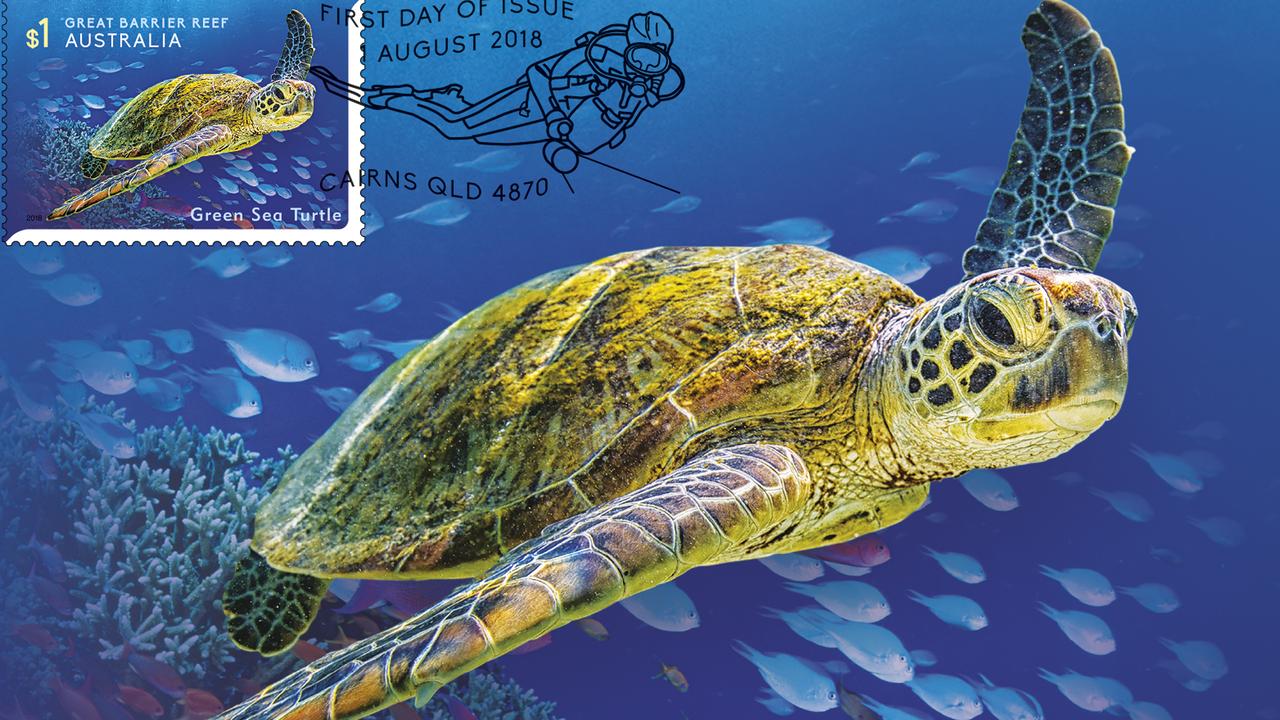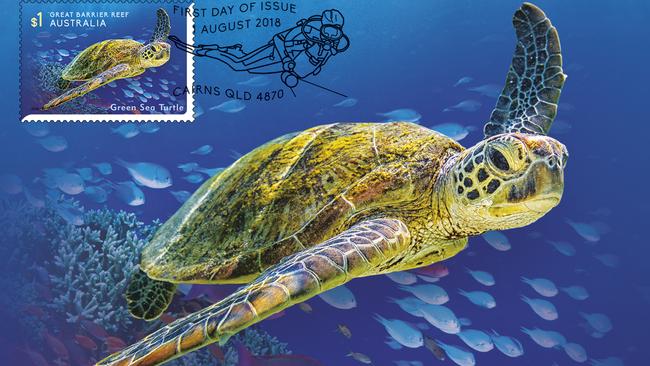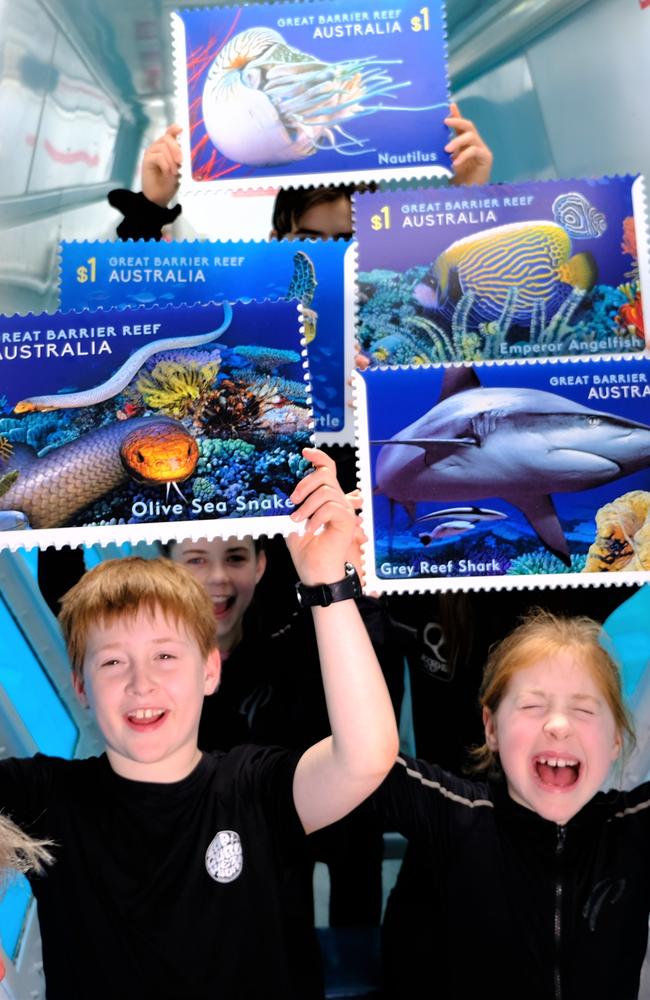Great Barrier Reef stamp series aims to raise awareness of the fight to save our natural wonder
A new Great Barrier Reef stamp series from Australia Post aims to raise awareness of the fight to save our natural wonder while also celebrating Stamp Collecting Month

READING LEVEL: GREEN
More than one million Australians collect stamps as a hobby*.
August is Australia’s official stamp collecting month and Australia Post has released a new set of collectable stamps with the theme Reef Safari. The stamps are designed to highlight the beauty and amazing species that live on the Great Barrier Reef.
The release of the five stamps coincides* with the International Coral Reef Initiative naming this year the third International Year of the Reef.
Australia Post hopes the stamps will raise awareness of the Great Barrier Reef’s beauty but also its fight for survival because of climate change. The reef is one of the Seven Natural Wonders of the World and is one of Australia’s major tourist attractions.
The futures of all the animals highlighted on the stamps are under threat. They are:
1. Grey Reef Shark — $2 stamp
Curious and mostly seen in shallow water near the drop-offs of coral reefs. Bronze to grey in colour with a paler colour underneath. It has a black outline on its fin. This 2m long shark has an excellent sense of smell and eats bony fish.

2. Nautilus — $1 stamp
A distant cousin of the squid and octopus. Has up to 90 tenticles and a hard outer shell. Its sticky tenticles help it capture prey. It swims by sucking water into a chamber of its shell and then pushing the water out by pulling its body into the chamber, creating a jet propulsion to thrust itself backwards.
3. Olive Sea Snake — $1 stamps
A highly venomous snake that breathes air. Spends its whole life in the ocean and its large lungs allow it to stay underwater for hours. Grows up to 2m long and has a special tail that helps it hide in daylight. It eats small to medium fish and prawns and crabs.
4. Emperor Angelfish — $1 stamp
A thin fish that grows to 38cm long. Feeds on plants and small invertebrates* with its strong and bulky jaw. Its markings change with age. Young angelfish are blue with blue and white rings, while the adult fish have yellow and blue stripes with black around their eyes.
5. Green Sea Turtle — $1 stamp
One of six species of marine turtle found on the Great Barrier Reef. Commonly found in seaweed rich areas. Adults have smooth, high-domed olive-green shells (sometimes with brown or reddish-brown highlights). They use their paddle-like flippers for swimming and feed mostly on algae, seagrass and jellyfish.

Professor Ove Hoegh-Guldbert, director of the Global Change Institute and Professor of Marine Science at The University of Queensland, said he hoped the stamps would help educate people about the threats to the reef and its animals and reinforce* the need for climate action.
“Urgent protection is needed to save the reef, or Australia and the world risk losing a global treasure that provides enormous economic, social and environmental benefits to hundreds of millions of poeple.” he said.
Australia Post general manager of consumer Jane Cohen agreed, saying: “Sadly climate change has placed the reef under pressure like never before and we hope these stamps can highlight the things we can do to make a difference.”
The stamps are available to buy in August at Australia Post shops or online at auspost.com.au/stamps

HISTORY OF STAMPS
The first postal services in the world were only used by kings and governments. Messengers travelled on foot, horseback or even by ship carrying each message. It could take them several days (or even weeks or months) to reach their destination.
Eventually, ordinary people wanted to send messages this way, too. When the first public postal service began, the person who received the letter had to pay the delivery charge, not the person who sent it. Many letters weren’t delivered because people refused to pay.
An Englishman named Rowland Hill came up with the idea of pre-paying postage with a “stamp” in 1837. He recommended a standard letter rate of one penny (about 1c) for each half an ounce (14g), no matter how far it had to be carried for delivery
STAMP DESIGNS
Making a stamp usually takes about two years. Researchers, illustrators, photographers, designers, printers and marketers are all involved in the process of stamp making.
Each finished stamp must include the word “Australia” and the price of the stamp. The stamp designer also needs to include the year of issue on the stamp, small enough not to mess up the design, but large enough to read.

WHY COLLECT STAMPS?
Most people do it just for fun or because they are interested in a favourite topic such as sport, animals or space exploration.
People also collect stamps because they like to have keepsakes* from special events and to mark special occasions. Also, some stamps can be rare and worth a lot of money if you are lucky enough to find them.
STAMP COLLECTING FACTS
(Source: auspost.com.au/education)
- The first national stamp release in Australia was in 1913. The stamp featured a kangaroo on a map of Australia.
- Australia’s youngest stamp designer is Holly Alvarez of Perth. She was only five years old when her design for a 1983 Christmas stamp was chosen in a national competition for primary school children.
- The first stamp collector was John Bourke, Receiver-General of Stamp Duties in Ireland. He formed a collection of stamps in an album in 1774.
- The first person other than royalty to appear on a British stamp was William Shakespeare in 1964.
GLOSSARY
- hobby: an activity regularly done for pleasure
- coincides: occurs at the same time
- invertebrates: an animal lacking a backbone
- reinforce: strengthen or support
- keepsakes: an item kept in memory of someone or something
LISTEN TO TODAY’S STORY
QUICK QUIZ
- What is the theme of this year’s Stamp Collecting Month?
- What does Australia Post hope the stamp series will help achieve?
- Who invented pre-paid postage?
- How long does it take to make a new stamp?
- In which year did John Bourke form the first stamp collection?
CLASSROOM ACTIVITIES
1. Important things or people are put on stamps.
Think about something important or people you think should be on the next series of stamps for Australia Post.
Design four stamps for your series. Don’t forget to make sure you follow Australia Post’s rule for stamp design.
Time: Allow 45 minutes
Curriculum Links: Visual Communication Design.
2. Extension
Imagine that you are going to ask Australia Post to use your stamps. Create a design portfolio for your stamp series. Your portfolio should include your designs and a report on the things or people you have chosen. This is to make sure Australia Post knows all about it. You should also write a letter explaining why the things or people are important enough to be on stamps.
Time: Allow 60 minutes
Curriculum Links: Visual Communication Design, English
VCOP ACTIVITY
After reading the article, with a partner, highlight as many pieces of punctuation as you can find in green. Discuss how these are being used, where and how often. What level of the punctuation pyramid is the journalist using in this article?
HAVE YOUR SAY: If you were to start collecting stamps, what topic or series would you like to collect (ie, AFL footballers, native flowers, animal etc)?
No one-word answers. Use full sentences to explain your thinking.

